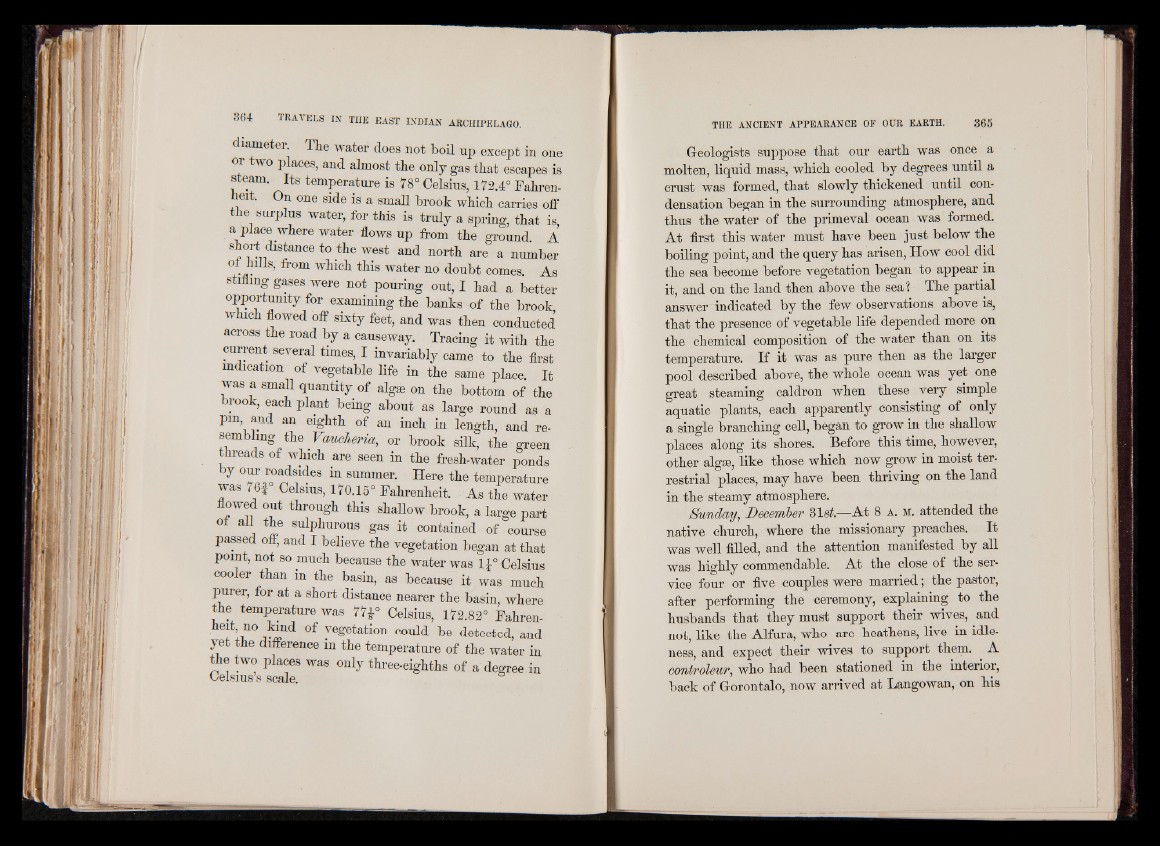
diameter. The water does not boil up except in one
or two places, and almost the only gas that escapes is
steam. Its temperature is 78° Celsius, 172.4° Fahrenheit.
On one side is a small brook which carries off
the surplus water, for this is truly a spring, that is,
a place where water flows up from the ground. A
short distance to the west and north are a number
from wHcl1 this water no doubt comes. As
stifling gases were not pouring out, I had a better
opportunity for examining the banks of the brook
which flowed off sixty feet, and was then conducted
across the road by a causeway. Tracing it with the
current several times, I invariably came to the first
indication of vegetable life in the same place It
was a small quantity of algae on the bottom of the
rook, each plant being about as large round as a
pm, and an eighth of an inch in length, and resembling
the Vaucheria, or brook silk, the green
threads of which are seen in the fresh-water ponds
by our roadsides in summer. Here the temperature
was 76f° Celsius, 170.15° Fahrenheit. As the water
flowed out through this shallow brook, a large part
ot all the sulphurous gas it contained of course
passed off, and I believe the vegetation began at that
point, not so much because the water was 1£° Celsius
cooler than in the basin, as because it was much
purer, for at a short distance nearer the basin, where
the temperature was 7 7 |0 Celsius, 172.82° Fahren-
°f Vegetation could be detected, and
yet the difference in the temperature of the water in
the two places was only three-eighths of a degree in
Celsius’s scale.
Geologists suppose that our earth was once a
molten, liquid mass, which cooled by degrees until a
crust was formed, that slowly thickened until condensation
began in the surrounding atmosphere, and
thus the water of the primeval ocean was formed.
At first this water must have been just below the
boiling point, and the query has arisen, How cool did
the sea become before vegetation began to appear in
it, and on the land then above the sea? The partial
answer indicated by the few observations above is,
that the presence of vegetable life depended more on
the chemical composition of the water than on its
temperature. If it was as pure then as the larger
pool described above, the whole ocean was yet one
great steaming caldron when these very simple
aquatic plants, each apparently consisting of only
a single branching cell, began to grow in the shallow
places along its shores. Before this time, however,
other algæ, like those which now grow in moist terrestrial
places, may have been thriving on the land
in the steamy atmosphere.
Sunday, December 31s#.—At 8 a . m. attended the
native church, where the missionary preaches. It
was well filled, and the attention manifested by all
was highly commendable. At the close of the service
four or five couples were married 5 the pastor,
after performing the ceremony, explaining to the
husbands that they must support their wives, and
not, like the Alfura, who are heathens, live in idleness,
and expect their wives to support them. A
contrôleur, who had been stationed in the interior,
back of Gorontalo, now arrived at Langowan, on his